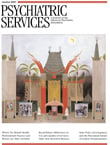Letter
Ratings of Coercive Interventions by Inpatients and Staff in Germany
To the Editor: In a study reported in the June issue, Whittington and colleagues ( 1 ) asked inpatients and staff at acute care facilities in England to rate 11 types of coercive interventions. Between 2003 and 2005 we conducted a study in Germany of 102 service users exposed to a coercive intervention in the previous month (60 patients experienced seclusion and 42 experienced mechanical restraint). Also included were 32 staff members who had carried out some of these interventions (50 incidents of seclusion and 30 of mechanical restraint). We assessed participants' general views of such interventions and their views of interventions in which they were involved.
The findings support and enhance those of Whittington and colleagues. For example, we found that, in general, participants most strongly disapproved of net beds and mechanical restraints. When service users were shown photographs of coercive interventions and asked to rate them regardless of which intervention they had experienced, they rated seclusion as the most appropriate. When staff were asked to rate only those interventions in which they had been involved, they rated the intervention that they had applied as most appropriate.
When service users were shown a photograph of mechanical restraint, those who experienced mechanical restraint in the past month rated it as significantly more appropriate than did service users who experienced seclusion in the past month. This finding seems to argue strongly against deriving evidence about which interventions are least restrictive from questionnaire studies that assess general attitudes. Comparing participants' subjective experience by use of controlled designs is the best approach ( 2 , 3 ).
The statement by Whittington and colleagues that "evidence was found of strong disapproval among both staff and service users with regard to the introduction of mechanical restraint" is appropriate for England, where it has never been used, but these findings cannot be generalized to other countries. We assume that service users and staff most strongly approve of interventions with which they are familiar and most strongly disapprove of those which they have seen only in photographs. For countries where net beds are used—for example, Austria, Slovakia, and the Czech Republic—we have no data to compare attitudes of staff and service users toward net beds and toward seclusion or restraint. Attitudes toward net beds might be much more positive in these countries, because patients in net beds have more freedom to move than those in mechanical restraint and more opportunity to communicate than those in seclusion.
However, some ethical aspects of coercive measures cannot be addressed by randomized controlled trials: Is it ethical to keep humans in cages? Is it ethical to keep them fixed with belts in five points? Coercive interventions are an issue not only of medicine and evidence but also of specific cultures, and research must take these cultural aspects into account. Even if individuals' disapproval of manual restraint, locked-door seclusion, and coerced intramuscular medication increased with their experience of these interventions, we believe that the conclusion of Whittington and colleagues—that these methods should be avoided as much as possible—should be applied to different cultures with caution.
1. Whittington R, Bowers L, Nolan P, et al: Approval ratings of inpatient coercive interventions in a national sample of mental health service users and staff in England. Psychiatric Services 60:792–798, 2009Google Scholar
2. Bergk J, Einsiedler B, Steinert T: Feasibility of randomized controlled trials on seclusion and mechanical restraint. Clinical Trials 5:356–363, 2008Google Scholar
3. Sailas E, Fenton M: Seclusion and restraint for people with serious mental illnesses. Cochrane Database of Systematic Reviews, 2000. Available at DOI 10.1002/14651858. CD001163Google Scholar



